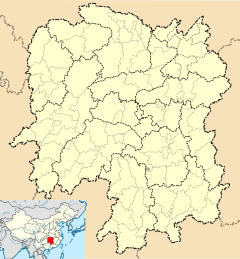Former Residence of Hu Yaobang
| Former Residence of Hu Yaobang | |
|---|---|
胡耀邦故居 | |
 Entrance of the Former Residence of Hu Yaobang. | |
| General information | |
| Type | Traditional folk houses |
| Architectural style | Chinese architecture |
| Location | Zhonghe Town, Liuyang, Hunan |
| Country | China |
| Coordinates | 28°04′54″N 113°53′07″E / 28.081674°N 113.885279°E |
| Completed | 1851–1862 |
| Owner | Government of Liuyang |
| Technical details | |
| Material | Brick and wood |
| Floor area | 450 m2 (4,800 sq ft) |
| Design and construction | |
| Architect(s) | Hu Mingzhong Hu Mingjing |
The Former Residence of Hu Yaobang or Hu Yaobang's Former Residence (Chinese: 胡耀邦故居; pinyin: Hú Yàobāng Gùjū) was built during the Xianfeng period of the Qing Dynasty(1851-1862) and is located in Cangfang Village, Zhonghe Town, Liuyang, Hunan.[1] It covers a building area of about 450-square-metre (4,800 sq ft) including buildings such as the old houses, Yaobang Square, the ancestral temple, the ancestral grave, the Cultural Relic Exhibition Hall, and the old well.[1][2][3][4][5][6]
History[edit]
The residence was built by Hu Yaobang's great-grandfather Hu Mingzhong (胡明鍾) and Hu Mingzhong's elder brother Hu Mingjing (胡明鏡) in the Qing dynasty during the reign of the Xianfeng Emperor (1851–1862).
On 13 November 1915, Hu Yaobang was born in the home. Here, he spent his childhood and youth until October 1930 when he was transferred to be the director of the Xiangdong Children's Bureau stationed in Anyuan, Jiangxi, before leaving his hometown.
In 1962, when Hu Yaobang returned home and visited it, he told his relatives not to rebuild the home. Despite this wish, the residence was rebuilt in February 1995 by the People's Government of Liuyang City. In September, Hu Yaobang's wife Li Zhao (李昭) visited the residence. The next year, the residence was listed as a Hunan Province most important culture and relics site.
In 2002, it was listed as a Provincial Patriotic Education Base. In February 2005, the Cultural Relic Exhibition Hall was built. On 6 May 2013, it was listed as a "Major National Historical and Cultural Sites" by the State Council of China.[1] On 12 April 2014, Hu Jintao visited the residence.[7][8][9] In December 2020, it was rated as the fourth batch of national first-class museums.[10]
Gallery[edit]
References[edit]
- ^ a b c Wang Xijia (2014), p. 19.
- ^ 红色旅游 长沙市浏阳胡耀邦故里旅游区. sina (in Chinese). 2013-07-15.
- ^ 胡耀邦故居成全国重点文保单位 去年获批4A景区. Tencent (in Chinese). 2013-05-07.
- ^ 走进湖南胡耀邦故居. sohu (in Chinese). 14 April 2014.
- ^ 胡耀邦故居列入第七批全国重点文物保护单位. people.com.cn (in Chinese). 2013-05-06.
- ^ 港媒:胡锦涛到访胡耀邦故居 向其铜像鞠躬致敬. 163.COM (in Chinese). 14 April 2014. Archived from the original on 21 August 2014.
- ^ Zhang Wenzhong (张文中) (2014-04-17). 胡锦涛参观胡耀邦故居有什么政治含意?. rfi.fr (in Chinese). Retrieved 2019-11-11.
- ^ 胡锦涛敏感时机参访胡耀邦故居. voachinese.com (in Chinese). 2014-04-12. Retrieved 2019-11-11.
- ^ 胡锦涛上周五参观胡耀邦故居. qq.com (in Chinese). 2014-04-14. Retrieved 2019-11-11.
- ^ "第四批国家一级博物馆名单" (PDF). 中国博物馆协会. 2020-12-21.
Bibliography[edit]
- Wang Xijia (2014). 长沙史话 [A Brief History of Changsha] (in Chinese). Beijing: Social Sciences Academic Press. ISBN 978-7-5097-6662-0.







